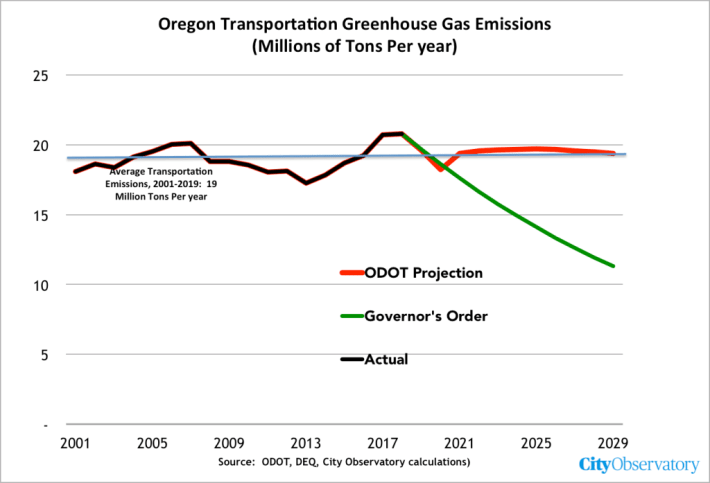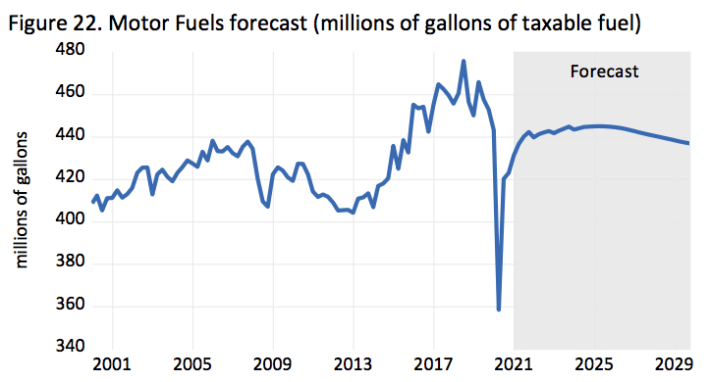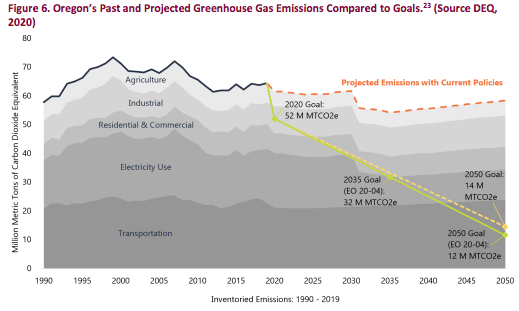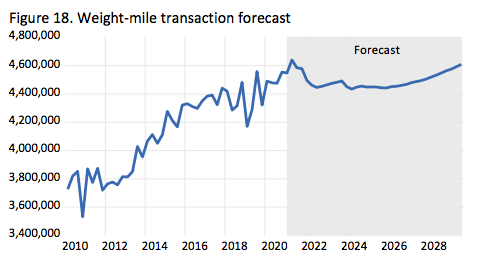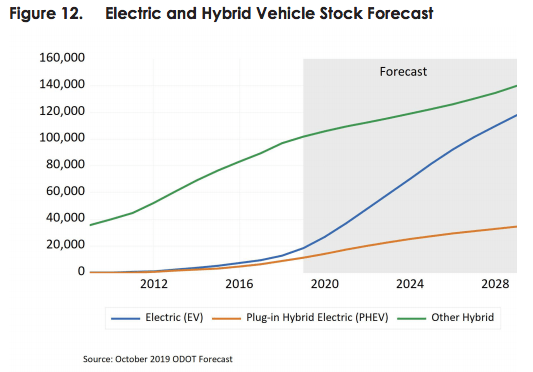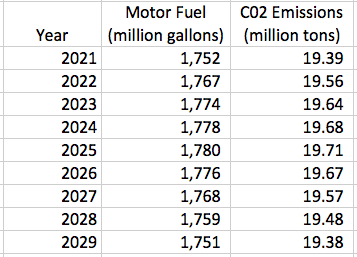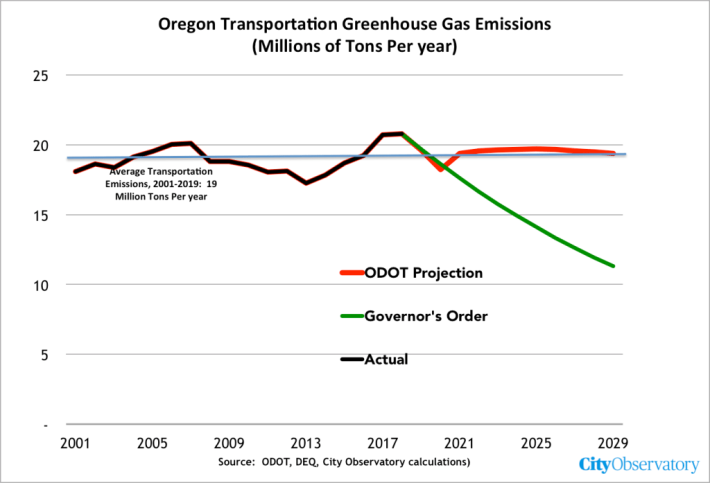Editor's note: this article originally appeared on City Observatory and his been republished with permission.
The Oregon Department of Transportation is telling anyone who’ll listen about their supposed deep concern about climate change, and all the actions they’re taking to reduce greenhouse gas emissions. It’s a splashy PR campaign, with a newly minted “climate office” and a “fig leaf” logo.
But that’s not the real story. The real story is told, not in the agency’s PR documents, but in its financial plans and projections. It’s told in the byzantine “official statement” it provides to bond markets. That real story is that the agency is planning on Oregon’s transportation system continuing to emit just as much greenhouse gases for the next decade as it does today. Its financial plans hinge on Oregonians buying, and burning enough gasoline and diesel into the 2030s to produce nearly 20 million tons of CO2 a year—roughly 20 percent more than was emitted in 1990, and nowhere near the state’s official target of cutting greenhouse gas emissions by 80 percent by 2050 (and far below interim targets established by Governor Brown).
Oregon Governor Kate Brown’s climate emergency order calls for reducing greenhouse gas emissions by 45 percent from 1990 levels by 2035; ODOT is counting on fuel consumption that will produce greenhouse gas levels of 19.4 million tons in 2030; nearly 20 percent higher than in 1990, and 70 percent higher than the amount needed to be on track to meet the Governor’s stated goal.
This department’s revenue forecast belies claims that any of the actions it’s hoping for, including electric vehicle adoption or more efficient internal combustion vehicles will do anything in the next decade to reduce Oregon’s transportation greenhouse gas emissions.
ODOT predicts we’ll continue buying and burning 1.7 billion gallons of taxable motor fuel every year, through 2030. This coupled with other transportation fuels, in turn, will produce 19.4 million tons of greenhouse gases annually through 2029.
Here’s ODOT’s latest (April, 2021) forecast of quarterly taxable motor vehicle fuel sales. (This doesn’t include sales of diesel fuel for large, over the road trucks which pay the state’s weight-mile tax). As you can see, these quarterly figures show long term consumption of motor fuels stabilizing at a bit more than 440 million gallons per quarter (about 1,760 million gallons annually) through the remainder of the decade.
Burning gasoline and diesel fuel translates directly into more greenhouse gas emissions. It’s very straightforward to estimate the greenhouse gas emissions that result from burning a gallon of gasoline. Each gallon of gas, when burnt, produces 8.87 kilograms (almost 20 pounds) of CO2. That means burning 1.75 billion gallons of gasoline will result in about 15.6 million metric tons of carbon dioxide (1,750,000,000 * 8.87). Burning diesel fuels accounts for most of the rest of the 19.3 million in emissions (see further discussion of diesel fuel consumption, below).
The continued burning of all this fossil fuel is completely inconsistent with Oregon’s stated climate goals. As illustrated by the green line in our first chart, Governor Brown’s Executive Order 20-04 implies a much more rapid and dramatic decline in greenhouse gases, and therefore, fossil fuel consumption. This same point has been made by the Oregon Global Warming Commission, which has sketched out the path to meeting the state’s 2050 goal of reducing greenhouse gases to no more than 20 percent of 1990 levels. (See the yellow dashed lines).
It’s worth noting, as we’ve pointed out before at City Observatory, that the most effective means of reducing gasoline consumption (and greenhouse gases) was higher fuel prices. Fuel prices which rose steadily from 2004 through 2008, and which remained high until 2014, had the effect of reducing Oregon’s total gas consumption by almost 10 percent. When gasoline prices plunged by almost 40 percent in 2014, following the collapse of global oil prices, Oregon’s gasoline consumption surged from about 400 million to about 470 million gallons per quarter (seasonally adjusted). This was the principal reason that the state saw big increases in greenhouse gas emissions from transportation over this time period.
Although it doesn’t explicitly say so, presumably these official ODOT forecast reflect the net effects of improving vehicle efficiency, increasing numbers of electric vehicles, and ODOT’s much vaunted “operational improvements” (i.e. electronic sign boards along highways). What ODOT’s official revenue forecasts are telling us is that the agency fully expects us to be generating just as much greenhouse gases from driving in 2030 as we are today; indeed, the agency is counting on it, to pay its bills.
If the agency seriously believed in its climate strategy, then it would be planning for and predicting a steady decline in gasoline consumption, as we adopted more efficient vehicles, electrified and “made every mile count.” But as its financial projections make clear, the agency has no faith that any of these measures will make any substantive difference to gasoline consumption (and therefore, greenhouse gas emissions).
Diesel Emissions
And gasoline-based CO2 emissions are just part of the puzzle. The ODOT taxable motor fuels forecast exclude diesel fuel burned by vehicle subject to Oregon’s weight-mile tax, which is applied to heavy over-the-road trucks. The Oregon Department of Environmental Quality reports that these sources represent about 23 percent of transportation greenhouse gas emissions:
In addition to the health effects, combustion of diesel fuel is a significant source of greenhouse gas emissions. Transportation accounts for approximately 40 percent of all statewide greenhouse gas emissions in Oregon. This represents the largest source of emissions and a source that has seen increased emissions in recent years. While heavy-duty trucks and buses, which typically are fueled by diesel, only account for four percent of vehicles on the road nationally, they are responsible for nearly 25 percent of total transportation sector greenhouse gas emissions nationally, and 23 percent in Oregon. Emissions from trucks are one of the fastest growing sources of greenhouse gas emissions, and the number of truck miles traveled on the nation’s roads is projected to continue to grow significantly in the coming decades.
In its 2018 inventory, DEQ estimates that burning distillate fuels (of which diesel is the bulk), account for about 7 million tons of greenhouse gases per year; equal to about 50 percent of the amount generated by burning gasoline in cars.
ODOT also has a prediction for these weight-mile taxes, which suggests that they, too will not decrease materially between now and 2030. That means that greenhouse gas emissions from diesel trucks will also not materially decline. ODOT predicts that weight-mile transactions will stabilize at 2019 levels through 2025 and then increase thereafter (Figure 18). In short, ODOT is saying that diesel truck emissions will likely remain at or above their current levels indefinitely.
And, no EVs will not save the day
The favorite dodge of highway apologists is to argue that electric vehicles will obviate the need to reduce driving at all. Never mind that the production and operation of electric vehicles isn’t zero carbon, best estimates are that life-cycle emissions from building EVs and their batteries and charging them will produce about 30 to 50 percent of the emissions of greenhouse gases as cars.
But ODOT doesn’t expect electric vehicles to be more than a token part of the fleet in the next decade. The agency’s October 2019 revenue forecast predicts the size and composition of Oregon’s light duty vehicle fleet through 2029. They forecast that in 2029 Oregon will have about 3.9 million light duty vehicles, but only about 120,000 of them (total) will be electric vehicles. That’s just three percent of the fleet; 97 percent will still be internal combustion engines. The slow adoption of electric vehicles, as depicted in ODOT’s official revenue forecasts, means the agency believes that its efforts to promote EVs won’t have a significant effect on the state’s greenhouse gas emissions any time in the next decade, at least.
There’s a naive and wrong-headed argument going around among highway apologists, arguing that they don’t need to worry about climate change because vehicle electrification will somehow solve the problem. These data show that won’t happen fast enough, and in all likelihood won’t happen at all, as we continue to burn 1.7 billion gallons of taxable motor fuel a year in Oregon.
Financial projections show ODOT’s real priorities: More greenhouse gas pollution
As Upton Sinclair observed, “It is difficult to get a man to understand something, when his salary depends on his not understanding it.” What ODOT is saying, implicitly, is that their salaries depend on continued massive production of greenhouse gases.
In simple financial terms, ODOT is counting on — is planning on — Oregonians not doing anything to significantly reduce their consumption of fossil fuels between now and 2030. Its plans to pay for building new highways are based on the assumption that we reduce total fuel consumption by no more than a few percent in the next decade – at exactly the time when scientists (and our adopted climate plans) tell us we need to be making the most progress toward preventing climate catastrophe.
There’s a striking contrast between the precise and hard-nosed projections of ODOT’s revenue forecast (they’re counting on us buying and burning 1.7 million gallons of taxable motor fuel every year through 2030), and the vague, PR-infused, fuzziness of Oregon DOT’s Climate Action Plan. Part of this plan is an “Every Mile Counts” initiative, which, despite its name, doesn’t actually include any counts of vehicle miles traveled, any hard plans for reducing VMT, or any specific goals for 2030. Instead, it’s just a vague exhortation to maybe, if you’d like, drive a bit less. But there’s no serious plan to make that happen.
If you read the fine print of the agency’s climate plan, it’s also clear that their real priority is getting more money and building more roads. The climate plan contains no stated goal for reducing greenhouse gas emissions from transportation (or VMT), but does specify as goals, assuring the agency has plenty of revenue and can keep building roads.
The agency’s real plan is reflected in its revenue forecast. ODOT is planning to spend billions widening highways, and is counting on us to buy just as much fossil fuel through the next decade as we’re buying now.
If you want to know what ODOT really cares about, and the future it’s really planning for, don’t be taken in by the gauzy and performative claims to care about climate, look at the agency’s financial plans. Money talks, and at ODOT it’s effectively saying, “we’re going to do nothing to significantly reduce greenhouse gases in Oregon, and we’re going to keep spending money to widen roads and encourage people drive more.”
Disobeying the Governor’s climate order
Oregon DOT’s financial plans show that the agency has no intention of even trying to comply with Governor Kate Brown’s Climate Emergency Order.
In 2020, the Governor ordered state agencies, including ODOT, to develop plans to reduce emissions to 45 percent below 1990 levels by 2035. According to DEQ, Oregon’s 1990 greenhouse gas emissions from transportation fuel consumption were 16.1 million tons. That implies that by 2035, the state’s total emissions from transportation fuels should be no higher than roughly (.55 * 16.1) 8.9 million tons. The pathway or glide slope required to reach that level of emissions requires roughly a 4.9 percent annual decrease in from 2018 through 2029. This glide slope implies that in 2029, emissions would need to be just under 12 million tons to be on track to meet the 2035 goal.
ODOT’s forecast makes it clear that through 2029, emissions from light duty cars and trucks (not to mention all other sources of transportation emissions, such as railroads, ships and aircraft) will be 70 percent greater than that amount—19.3 million tons.
Section 4(c)(2) of the executive order makes it clear that the 45 percent reduction applies separately to transportation fuels (e.g. gasoline and diesel fuel); the Department of Environmental Quality is directed to come up with rules that will achieve these reductions separately for transportation fuels. Agencies like ODOT can’t claim that they’ll be able to pollute more because other sectors of the economy will somehow make even larger reductions in greenhouse gas emissions.
In effect, ODOT is keeping two sets of books. Except that one set of books, doesn’t actually have any hard information, just vague and unverifiable claims about values and a lot of noble intent. The real books — the ones with dollars and cents, and millions and millions of tons of greenhouse gases locked-in — are hidden in plain sight. And the agency’s climate plans make no mention of how inconsistent the agency’s real financial plan is with its purported climate goals. It’s a fraud and deception, pure and simple.
Appendix: Transportation Fuels and Greenhouse Gases in Oregon
As noted, Oregon DOT forecasts taxable motor fuels sold and weight-mile transactions (a proxy for total weight mile truck volume) through 2029. Motor fuels, when burned, produce greenhouse gases.
We’ve estimated average transportation emissions from gasoline and diesel in Oregon based on the historic relationship between the ODOT taxable motor fuels volume estimate and the DEQ annual transportation sector greenhouse gas estimate for on road gasoline and diesel fuel consumption. On average, between 2004 and 2019, the consumption of 1,000 gallons of taxable motor fuel (as estimated by ODOT) was associated with an estimated 11.07 metric tons of transportation fuel carbon dioxide (as estimated by DEQ). We apply this relationship to ODOT’s 2021-2029 projections to estimate greenhouse gases associated with transportation fuel consumption.
These figures likely underestimate CO2 emissions, inasmuch as ODOT projects weight-mile activity and associated diesel heavy truck emissions to increase faster than taxable motor fuels activity through 2029. In addition, it’s worth noting that the DEQ sector estimates are considerably lower than those used in the evaluation of Oregon’s Clean Fuels Program (CFP). The CFP requires that gasoline and diesel fuel in Oregon be blended with ethanol and biodiesel to reduce the total carbon content of fuels burnt. The methodology used to calculate emissions under the CFP is a “well-to-wheels” metric, that counts all of the carbon emissions associated with production, refining and transport, as well as combustion, as opposed to the EPA factor which is a “tank to wheels” metric, counting just the carbon from combustion. The CFP well-to-wheels emission factor is about 12.3 kilos of carbon per gallon of conventional gasoline, compared to the EPA “tank-to-wheels” emission factor of 8.78 kilos of carbon per gallon of conventional gasoline. If the “well-to-wheels” approach is actually correct, this may mean that current estimates used by DEQ in its sector inventory substantially understate the relative contribution of transportation fuels to Oregon’s greenhouse gas emissions.
ODOT’s forecast only explicitly included taxable motor fuel sales, i.e. gasoline and diesel fuel used to power cars and light and medium sized trucks. Sales of diesel fuel to larger over the road trucks is exempt from this tax, as these trucks pay the weight-mile tax instead.
The Oregon Office of Economic Analysis computes the carbon intensity of gasoline and diesel sold in Oregon under the Clean Fuels program. It estimates that the total net effect of the program has been (which blends 10 percent ethanol with conventional gasoline, and a similar amount of biodiesel with conventional diesel), is to reduce greenhouse gas emissions from fuel consumption by an aggregate of about 5 percent, based on a “well-to-wheels” analysis. The potential for increasing biofuels is limited; nearly 90 percent of gas-powered vehicles on the road today can only burn a maximum of ten percent ethanol. Increasing ethanol production would have serious negative environmental impacts.
ODOT forecasts that taxable motor fuel sales in 2029 will be 1,751 million gallons. That’s slightly more than the average fuel consumption for the years 2004 through 2019 (about 1,723 million gallons per year). DEQ estimates that total transportation emissions from motor gasoline and distillate fuel (chiefly diesel) were about 19.6 million tons in 2019, about 22 percent above their 1990 level of 16.1 million tons. The following chart shows estimated carbon emissions from motor gasoline and diesel fuel in Oregon, grown at the rate of increase of taxable motor fuel sales, for the period 2021 through 2029, per the ODOT Forecast.
Author's Note: Thanks to Daniel Porter of ODOT and Michael Kennedy of OEA for sharing in spreadsheet form the data contained in their estimates.

